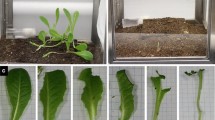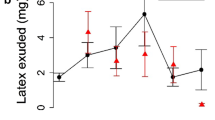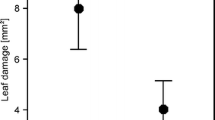Abstract
Trophic cascades occur when predators benefit plants by consuming herbivores, but the overall strength of a trophic cascade depends upon the way species interactions propagate through a system. For example, plant resistance to, or tolerance of, herbivores reduces the potential magnitude of a trophic cascade. At the same time, plants can also affect predator foraging or consumption in ways that either increase or decrease the strength of trophic cascades. In this study, we investigated the effects of plant variation on cascade strength by manipulating predator access to aphid populations on two species of milkweed: the slower-growing, putatively more-defended Asclepias syriaca and the faster-growing, putatively less-defended Asclepias incarnata. Predatory insects increased plant growth and survival for both species, but the strength of these trophic cascades was greater on A. incarnata, which supported more aphid growth early in the season than did A. syriaca. More predators were observed per aphid on A. incarnata, and cage treatments generated significant patterns consistent with predator aggregation on A. incarnata, but not A. syriaca. Although predators strongly affected aphids, this effect did not differ consistently between milkweed species. Plant tolerance to herbivory may therefore be the primary driver of the difference in trophic cascade strength observed. Importantly, we observed that the timing of predator exclusion affected plant growth and survival differently, indicating that measures of “cascade strength” may change with phenology and plant physiological responses. Together, our results suggest a mechanism by which differences in resource allocation patterns could explain differences in growth, phenology, and cascade strength between species.




Similar content being viewed by others
References
Agrawal AA (2004) Plant defense and density dependence in the population growth of herbivores. Am Nat 164:113–120. doi:10.1086/420980
Agrawal AA (2005) Natural selection on common milkweed (Asclepias syriaca) by a community of specialized insect herbivores. Evol Ecol Res 7:651–667
Agrawal AA, Fishbein M (2006) Plant defense syndromes. Ecology 87:S132–S149
Agrawal AA, Fishbein M (2008) Phylogenetic escalation and decline of plant defense strategies. Proc Natl Acad Sci USA 105:10057–10060. doi:10.1073/pnas.0802368105
Agrawal AA, Erwin AC, Cook SC (2008) Natural selection on and predicted responses of ecophysiological traits of swamp milkweed (Asclepias incarnata). J Ecol 96:536–542. doi:10.1111/j.1365-2745.2008.01365.x
Agrawal AA, Petschenka G, Bingham RA, Weber MG, Rasmann S (2012) Toxic cardenolides: chemical ecology and coevolution of specialized plant-herbivore interactions. New Phytol 194:28–45. doi:10.1111/j.1469-8137.2011.04049.x
Barton KE, Koricheva J (2010) The ontogeny of plant defense and herbivory: characterizing general patterns using meta-analysis. Am Nat 175:481–493. doi:10.1086/650722
Bell T (2002) The ecological consequences of unpalatable prey: phytoplankton response to nutrient and predator additions. Oikos 99:59–68. doi:10.1034/j.1600-0706.2002.990106.x
Borer ET, Seabloom EW, Shurin JB, Anderson KE, Blanchette CA, Broitman B, Cooper SD, Halpern BS (2005) What determines the strength of a trophic cascade? Ecology 86:528–537
Borer ET, Halpern BS, Seabloom EW (2006) Asymmetry in community regulation: effects of predators and productivity. Ecology 87:2813–2820
Bottrell DG, Barbosa P, Gould F (1998) Manipulating natural enemies by plant variety selection and modification: a realistic strategy? Annu Rev Entomol 43:347–367
Brett MT, Goldman CR (1996) A meta-analysis of the freshwater trophic cascade. Proc Natl Acad Sci 93:7723–7726
Chacón JM, Asplen MK, Heimpel GE (2012) Combined effects of host-plant resistance and intraguild predation on the soybean aphid parasitoid Binodoxys communis in the field. Biol Control 60:16–25
Coley PD, Bryant JP, Chapin FS (1985) Resource availability and plant antiherbivore defense. Science 230:895–899
Crawley MJ (2007) The R book. Wiley, West Sussex
de Roode JC, Pedersen AB, Hunter MD, Altizer S (2008) Host plant species affects virulence in monarch butterfly parasites. J Anim Ecol 77:120–126. doi:10.1111/j.1365-2656.2007.01305.xER
Desneux N, Barta RJ, Hoelmer KA, Hopper KR, Heimpel GE (2009) Multifaceted determinants of host specificity in an aphid parasitoid. Oecologia 160:387–398. doi:10.1007/s00442-009-1289-x
Evans EW (2008) Multitrophic interactions among plants, aphids, alternate prey and shared natural enemies—a review. Eur J Entomol 105:369–380
Fornoni J (2011) Ecological and evolutionary implications of plant tolerance to herbivory. Funct Ecol 25:399–407. doi:10.1111/j.1365-2435.2010.01805.x
Fox J, Weisberg S (2011) An R companion to applied regression. Sage, Thousand Oaks
Groeters FR (1993) Tests for host-associated fitness trade-offs in the milkweed-oleander aphid. Oecologia 93:406–411
Hairston NG, Smith FE, Slobodkin LB (1960) Community structure, population control, and competition. Am Nat 94:421–425
Hare JD (2002) Plant genetic variation in tritrophic interactions. In: Tscharntke T, Hawkins BA (eds) Multitrophic level interactions. Cambridge Books Online, Cambridge, pp 8–43
Heil M (2008) Indirect defence via tritrophic interactions. New Phytol 178:41–61. doi:10.1111/j.1469-8137.2007.02330.x
Helms SE, Connelly SJ, Hunter MD (2004) Effects of variation among plant species on the interaction between a herbivore and its parasitoid. Ecol Entomol 29:44–51
Hochwender CG, Marquis RJ, Stowe KA (2000) The potential for and constraints on the evolution of compensatory ability in Asclepias syriaca. Oecologia 122:361–370
Hothorn T, Bretz F, Westfall P (2008) Simultaneous inference in general parametric models. Biom J 50:346–363
Ivey CT, Lipow SR, Wyatt R (1999) Mating systems and interfertility of swamp milkweed (Asclepias incarnata ssp. incarnata and ssp. pulchra). Heredity 82:25–35
Kersch-Becker MF, Thaler JS (2015) Plant resistance reduces the strength of consumptive and non-consumptive effects of predators on aphids. J Anim Ecol 84:1222–1232
Malcolm SB (1986) Aposematism in a soft-bodied insect—a case for kin selection. Behav Ecol Sociobiol 18:387–393
Malcolm SB (1989) Disruption of web structure and predatory behavior of a spider by plant-derived chemical defenses of an aposematic aphid. J Chem Ecol 15:1699–1716. doi:10.1007/BF01012259
Malcolm SB (1990) Chemical defence in chewing and sucking insect herbivores: plant-derived cardenolides in the monarch butterfly and oleander aphid. Chemoecology 1:12–21
Malcolm SB (1991) Cardenolide-mediated interactions between plants and herbivores. In: Rosenthal GA, Berenbaum MR (eds) Herbivores: their interactions with secondary plant metabolites., Volume I: The chemical participantsAcademic Press Inc., London, pp 251–296
Malcolm SB (1992) Prey defence and predator foraging. In: Crawley MJ (ed) Natural enemies: the population biology of predators, parasites, and disease. Blackwell Scientific Publications, Boston, pp 458–475
Malcolm SB (1995) Milkweeds, monarch butterflies and the ecological significance of cardenolides. Chemoecology 5:101–117
Malcolm SB, Zalucki MP (1996) Milkweed latex and cardenolide induction may resolve the lethal plant defence paradox. Entomol Exp Appl 80:193–196
Marquis RJ, Whelan C (1996) Plant morphology and recruitment of the third trophic level: subtle and little-recognized defenses? Oikos 75:330. doi:10.2307/3546260
Mohl EK (2014) The multi-trophic context of plant defense: ecological and evolutionary implications of variation in milkweeds. Dissertation, University of Minnesota
Mooney KA, Jones P, Agrawal AA (2008) Coexisting congeners: demography, competition, and interactions with cardenolides for two milkweed-feeding aphids. Oikos 117:450–458. doi:10.1111/j.2007.0030-1299.16284.x
Mooney KA, Halitschke R, Kessler A, Agrawal AA (2010) Evolutionary trade-offs in plants mediate the strength of trophic cascades. Science 327:1642–1644. doi:10.1126/science.1184814
Murdoch WW (1966) “Community structure, population control, and competition”—A Critique. Am Nat 100:219–226
Ode PJ (2006) Plant chemistry and natural enemy fitness: effects on herbivore and natural enemy interactions. Annu Rev Entomol 51:163–185. doi:10.1146/annurev.ento.51.110104.151110
Oksanen L, Fretwell SD, Arruda J, Niemela P (1981) Exploitation ecosystems in gradients of primary productivity. Am Nat 118:240–261
Pinheiro J, Bates D, DebRoy S, Sarkar D, R Core Team (2014) nlme: linear and nonlinear mixed effects models. R package version 3, pp 1–117
Polis GA (1999) Why are parts of the world green? Multiple factors control productivity and the distribution of biomass. Oikos 86:3–15
Polis GA, Strong DR (1996) Food web complexity and community dynamics. Am Nat 147:813–846
Price PW, Bouton CE, Gross P, McPheron BA, Thompson JN, Weis AE (1980) Interactions among 3 trophic levels—influence of plants on interactions between insect herbivores and natural enemies. Annu Rev Ecol Syst 11:41–65
R Core Team (2013) R: a language and environment for statistical computing. R Foundation for Statistical Computing, Vienna
Ruppel RF (1983) Cumulative insect-days as an index of crop protection. J Econ Entomol 76:375–377
Schmitz OJ, Hamback PA, Beckerman AP (2000) Trophic cascades in terrestrial systems: a review of the effects of carnivore removals on plants. Am Nat 155:141–153
Schmitz OJ, Krivan V, Ovadia O (2004) Trophic cascades: the primacy of trait-mediated indirect interactions. Ecol Lett 7:153–163
Shurin JB, Gruner DS, Hillebrand H (2006) All wet or dried up? Real differences between aquatic and terrestrial food webs RID A-5166-2010. Proc R Soc B Biol Sci 273:1–9. doi:10.1098/rspb.2005.3377
Siefert A, Violle C, Chalmandrier L, Albert CH, Taudiere A, et al. (2015) A global meta-analysis of the relative extent of intraspecific trait variation in plant communities. Ecol Lett 18:1406–1419
Stevens MT, Kruger EL, Lindroth RL (2008) Variation in tolerance to herbivory is mediated by differences in biomass allocation in aspen. Funct Ecol 22:40–47. doi:10.1111/j.1365-2435.2007.01356.x
Strong DR (1992) Are trophic cascades all wet—differentiation and donor-control in speciose ecosystems. Ecology 73:747–754
Tao L, Hunter MD (2013) Allocation of resources away from sites of herbivory under simultaneous attack by aboveground and belowground herbivores in the common milkweed, Asclepias syriaca. Arthropod Plant Interact 7:217–224. doi:10.1007/s11829-012-9235-y
Tao L, Berns AR, Hunter MD (2014) Why does a good thing become too much? Interactions between foliar nutrients and toxins determine performance of an insect herbivore. Funct Ecol 28:190–196
Wise MJ, Abrahamson WG (2005) Beyond the compensatory continuum: environmental resource levels and plant tolerance of herbivory. Oikos 109:417–428
Wise MJ, Abrahamson WG (2007) Effects of resource availability on tolerance of herbivory: a review and assessment of three opposing models. Am Nat 169:443–454
Woodson RE (1954) The North American species of Asclepias L. Ann Mo Bot Gard 41:1–211
Zehnder CB, Hunter MD (2007) A comparison of maternal effects and current environment on vital rates of Aphis nerii, the milkweed-oleander aphid. Ecol Entomol 32:172–180
Acknowledgments
We thank P. Tiffin and R. Shaw for helpful comments on an earlier version of the work; E. Baeten, P. Day, J. Dregni, L. Fees, S. Gunderson, D. Lemerond, S. Lueth, D. Malepsy, J. Malepsy, J. Reynolds, R. Scheel, S. Wolf, and E. Xie for assistance in the field; A. Rendahl for statistical consulting; and the Dayton Fund of the Bell Museum of Natural History, the University of Minnesota, and a National Science Foundation IGERT Grant (NSF DGE-0653827) for funding.
Author information
Authors and Affiliations
Corresponding author
Ethics declarations
Conflict of interest
The authors declare that they have not conflicts of interest.
Additional information
Handling Editor: Heikki Hokkanen.
Electronic supplementary material
Below is the link to the electronic supplementary material.
Rights and permissions
About this article
Cite this article
Mohl, E.K., Santa-Martinez, E. & Heimpel, G.E. Interspecific differences in milkweeds alter predator density and the strength of trophic cascades. Arthropod-Plant Interactions 10, 249–261 (2016). https://doi.org/10.1007/s11829-016-9430-3
Received:
Accepted:
Published:
Issue Date:
DOI: https://doi.org/10.1007/s11829-016-9430-3




